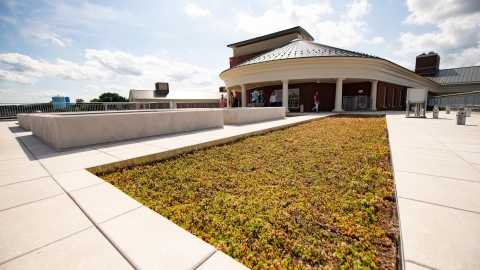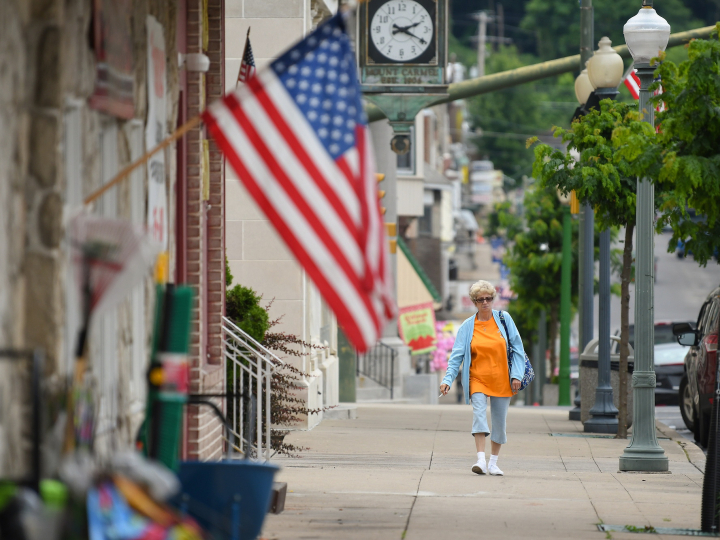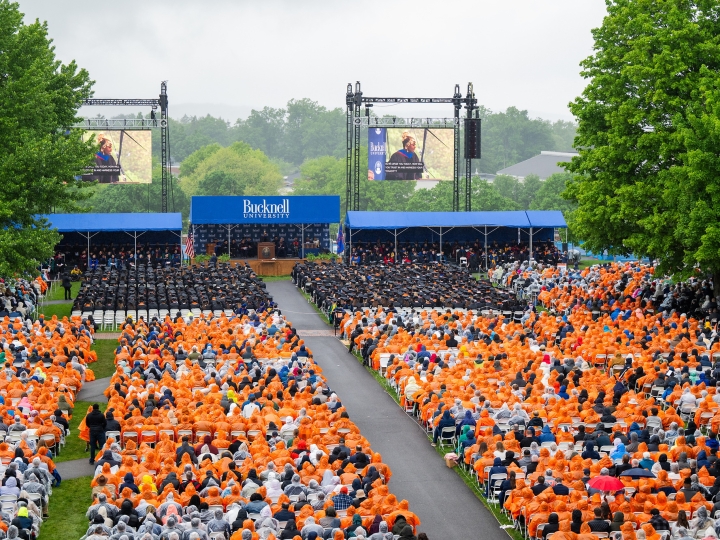
More Than a Plaque: How Bucknell’s Newest LEED Gold Building Benefits Students
February 24, 2021
A living roof that helps avoid high water runoff when it's raining and insulates the building when it's sunny is just one of the features that earned LEED Gold certification for Bucknell's Academic East building. Photo by Emily Paine, Communications
With room sensors that flag irregular energy use, a living roof that insulates the building naturally and a solar chimney that uses physics to keep the inside comfortable in any season, Bucknell's Academic East is a win for the environment.
But it's also a win for students and faculty. Those green-minded features do more than check off boxes on the way to LEED Gold certification. They have transformed Academic East into an active, vibrant place for research, innovation and headline-making discoveries.
When it opened in 2019, the 78,000-square-foot building vastly expanded the College of Engineering's lab footprint and also provided offices, labs, classrooms and research spaces for the Department of Education.
Bucknell's Facilities team achieved its goal of designing a building that both conserves resources and meets the needs of its occupants. To achieve that first goal, they consulted guidelines from the U.S. Green Building Council's Leadership in Energy and Environmental Design, or LEED, rating system.
To become LEED Gold certified, the building had to earn at least 60 points across a range of categories that measured site selection, water efficiency, energy performance, indoor environmental quality and innovation in design.
"We ended up with a building that operates in a more efficient manner, consumes less resources and provides a better-built environment for the occupants," says Stephen Durfee, campus energy manager.
Academic East is Bucknell's third LEED Gold building, joining MacDonald Commons and the South Campus Apartments.

The green wall inside Academic East doesn't just look great — it also purifies the air and helps promote calm and positivity. Photo by Emily Paine, Communications
A Win for Students
Many of Academic East's planet-friendly features double as research spaces for students and faculty.
That includes the green roof, which helps avoid high water runoff when it's raining and insulates the building when it's sunny.
"Think of it this way: Go out on a hot summer day, in bare feet, and walk on black pavement. Then go walk on grass. Which one's hotter?" says Dominic Silvers, director of planning, design & construction. "That vegetation just doesn't gain as much heat as other surfaces do."
Environmental engineers and students from other majors can access the roof and take advantage of specialized equipment to analyze the ways stormwater gets filtered through vegetation.
The story continues inside Academic East, where the Sustainability Command Center takes building automation to the next level.
Room sensors detect when a space is unoccupied and relax the temperature a couple of degrees. Built-in alerts indicate when an area is being simultaneously heated and cooled, thwarting wasteful (and costly) energy use. And exterior windows can be automatically opened to activate the three-story solar chimney, which draws cool air in and forces warm air out — offering natural ventilation.
At the heart of this futuristic building is the command center that is open to students. By studying real-time energy dashboards, engineering majors can learn how to make existing buildings more efficient through automation and artificial intelligence.
"There are fault detection diagnostics that flag something not operating optimally," Durfee says. "Then they can take the necessary actions. It's pretty sophisticated."
While students have been actively using many of Academic East's green-focused amenities, there are also plenty of passive features that, while they aren't used in research or coursework, still enhance the overall enjoyment of the space for students while earning more LEED points.
That includes a canopy angled to shade the building from the summer sun, a vertical living wall filled with oxygen-producing plants and abundant natural light made possible by thermally efficient glass throughout the building.
"It's all designed to be a good environment to be in, to learn in, to work in," says James Knight, director of energy & utilities.
But just like a curious student keeps searching for the next problem that needs solving, Bucknell's Facilities team has shifted its attention to the University's next project — creating a new space for the Freeman College of Management and Department of Art & Art History. That building, which opens this fall, has also been designed to meet LEED Gold specifications.
"The team continues to look for ways to do better each time we design a building," Durfee says. "The pressure's on."

Bucknell's Academic East earned its LEED Gold plaque by incorporating features that help lessen the building's impact on the environment. Photo by Emily Paine, Communications

